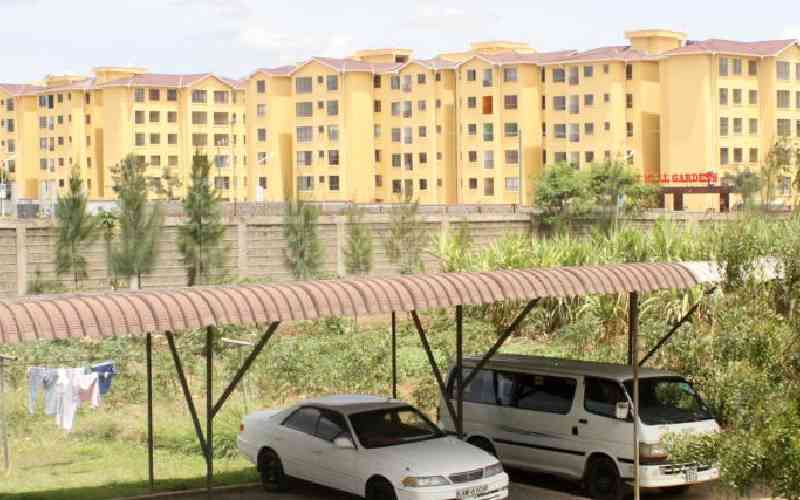By Morris Aron
Over the last 10 years, those who invested in real estate earned higher returns compared to those who traded at the Nairobi Stock Exchange (NSE), meaning that for profitable long-term investments, the property sector holds key.
An industry analysis by Stanbic Investments Management Services — one of the largest fund managers in East Africa with a property portfolio worth Sh20 billion — and HassConsult indicated that on average, earnings from the real estate sector since 2000 were three times more than stock market returns.
 |
News that real estate is profitable than the stocks comes at a time demand for housing in the middle and low-income group is at its peak. Photos: Martin Mukangu |
In addition, earnings from the property sector were consistent and inflation-proof compared to the bourse that has seen its shares go up and down.
“With this data, it is our belief that property is a strong asset class, which has been inflation-beating yet it is under exploited,” noted Mr Anthony Mwithiga chief investment officer at Stanbic Investment Management Services.
“The resilience of the housing market as a long-term investment has been proven by the fact that strong demand helped hold prices throughout the economic slowdown and the ongoing price recovery continues to drive overall property market returns.”
The analysis compared capital gains from property price appreciation and equities market. Capital gains is what an investor makes after they build or buy a property then sell it at a profit.
According to the analysis, wealth resulting from real estate investment grew by 183 per cent compared to returns from the equities market that stood at 125 per cent. The analysis also looked at rental yield vis-a-vis interest rate trends based on the 91-day Treasury Bills for the past ten years.
Rental yields — a measure of the percentage of income return from a rented property — was 0.9 per cent above the 91-day Treasury Bill.
The report notes that stand-alone houses and town houses were the key drivers of the capital gains made in the last ten years.
The lowest capital returns in the residential property sector have been in apartments, mainly attributed to an oversupply in certain areas with a bias to medium to high end of the market.
Market resilience
“The high-end apartment market is feeling the pinch of a demand-supply mismatch that led to oversupply,” said Jenny Luesby of African Laughter, who were the consultants for the HassConsult Property Index.
On average, stand-alone house units market capital growth over the last 10 years has been 251 per cent that is 3.5 times that of the stock market’s 125 percent.
Stay informed. Subscribe to our newsletter
The town house market capital growth over the last 10 years was 2.5 times that of the NSE performance at 155 per cent and 125 per cent respectively.
“The high-end apartment market can not be sold or rented out because of the changing tastes of the target middle class, whose aspiration is now to become part of the gated community,” said Mahamed Hassanali, the HassConsult managing director.
Good returns
“This should serve as a pointer to developers who are chasing good returns from the property market. Town houses and stand-alone houses is where to put the money,” he said.
News that real estate is profitable than the stocks comes at a time demand for housing in the middle and low income group is at its peak despite investors in the high-end apartment market having burnt their fingers, there is still room for growth, the analysts say.
“It is obvious that the next investment frontier in real estate is the middle class or below where housing shortage is most acute,” said Mwithiga.
The development is bound to spur increased interest in real estate in the middle and low-end of the market that is on take off phase, with mortgage companies coming up with incentives to attract and finance potential buyers.
Kenya Commercial Bank (KCB) recently raised Sh12.5 billion through a rights issue and is set to use part of the proceeds from the offer to support its mortgage business with its eye cast on mega real estate projects.
KCB can now afford to lend up to Sh7 billion to a single customer from Sh4 billion following the rights issue.
National Housing Corporation followed suit with plans to float a Sh10 billion housing bond to fund the middle income housing projects.
Housing Finance through a rights issue raised over Sh10 billion through the offer, money it intends to use to finance large-scale middle income housing schemes.
“What the mortgage companies are doing is that they are looking for a pool of long-term financing that is a crucial ingredient affordable to middle income, earners” Mr Mwithiga explained.
In addition to looking for long-time financing, commercial banks have in the second quarter of the year announced huge interest rate cuts in setting the stage for increased uptake of loans by corporations and individuals.
Biggest borrowers
Home loan lenders such as CFC Stanbic Bank, S&L and Barclays Bank slashed mortgage rates by between 1.5 and 4.5 per cent.
And for a moment, the efforts are beginning to show.
Recent statistics from Central Bank of Kenya (CBK) indicate that net lending to real estate grew from Sh43.3 billion to Sh81.7 billion in the year to June.
Household lending on the other hand rose from Sh84.3 billion to Sh118 billion — making homeowners and property developers the biggest borrowers in the local banking scene over that period.
The revelations of such trends is bound to push this appetite for the home loans market even further, especially given that returns from government debt, a favourite safe investment option by banks, including long-term bonds stand at below 10 per cent per annum.
Housing units
And as interest in investing in the middle-income housing units grows, so is price appreciation in that segment of the market.
On average, increased appetite for homeownership pushed house prices up for the first time in the third quarter of the year, reversing stagnation in the first two quarters and putting property on the path to reclaiming its place as the most attractive asset class for Kenyan investors.
But despite the attractive returns, affordble capital to invest in this lucrtaive sector remains thin, especially for middle and low income earners.
 The Standard Group Plc is a
multi-media organization with investments in media platforms spanning newspaper
print operations, television, radio broadcasting, digital and online services. The
Standard Group is recognized as a leading multi-media house in Kenya with a key
influence in matters of national and international interest.
The Standard Group Plc is a
multi-media organization with investments in media platforms spanning newspaper
print operations, television, radio broadcasting, digital and online services. The
Standard Group is recognized as a leading multi-media house in Kenya with a key
influence in matters of national and international interest.
 The Standard Group Plc is a
multi-media organization with investments in media platforms spanning newspaper
print operations, television, radio broadcasting, digital and online services. The
Standard Group is recognized as a leading multi-media house in Kenya with a key
influence in matters of national and international interest.
The Standard Group Plc is a
multi-media organization with investments in media platforms spanning newspaper
print operations, television, radio broadcasting, digital and online services. The
Standard Group is recognized as a leading multi-media house in Kenya with a key
influence in matters of national and international interest.









